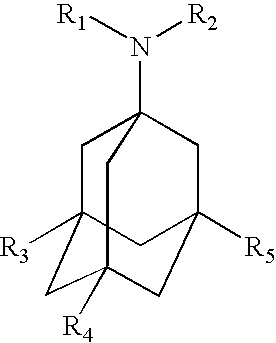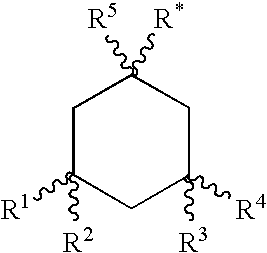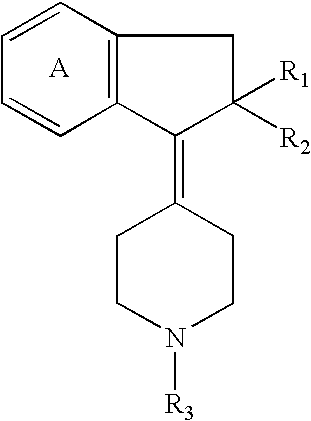Cyclic amine derivative or salt thereof
a technology of cyclic amine and derivatives, applied in the field of cyclic amine derivatives, can solve the problems of not revealing anything relating to the use of intermediates, and the safety margin of memantine as a medicine is still not satisfactory
- Summary
- Abstract
- Description
- Claims
- Application Information
AI Technical Summary
Benefits of technology
Problems solved by technology
Method used
Image
Examples
reference example 1
3-(3-Bromo-4-fluorophenyl)propionic acid
[0083] Piperidine (1 ml) was added to a pyridine (250 ml) solution of 3-bromo-4-fluorobenzaldehyde (20 g) and malonic acid (51 g), followed by heating under reflux for 3 hours. After completion of the reaction, the solvent was evaporated under reduced pressure, water was added, and this was neutralized with 1 N hydrochloric acid added thereto with stirring. The precipitated matter was collected by filtration, and the resulting (2E)-3-(3-bromo-4-fluorophenyl)acrylic acid was dissolved in THF (200 ml), followed by stirring with 5% Rh—C (3 g) in a hydrogen atmosphere at room temperature for 12 hours. The insoluble matter was removed by filtration, and the solvent was evaporated under reduced pressure to obtain the compound (15 g) of Reference Example 1.
[0084] In Reference Example 2, the compound shown in Table 2 was produced in the same manner as in Reference Example 1.
reference example 3
3-(2-Fluoro-5-methylphenyl)propionic acid
[0085] Piperidine (0.3 ml) was added to a pyridine (50 ml) solution of 2-fluoro-5-methylbenzaldehyde (4.2 g) and malonic acid (16 g), followed by heating under reflux for 3 hours. After completion of the reaction, the solvent was evaporated under reduced pressure, water was added, and this was neutralized with 1 N hydrochloric acid added thereto with stirring. The precipitated matter was collected by filtration, and the resulting (2E)-3-(2-fluoro-5-methylphenyl)acrylic acid was dissolved in a mixed solvent (70 ml) of THF and EtOH, followed by stirring with 10% Pd—C (0.5 g) in a hydrogen atmosphere at room temperature for 12 hours. The insoluble matter was removed by filtration, and the solvent was evaporated under reduced pressure to obtain the compound (5.1 g) of Reference Example 3.
[0086] In Reference Examples 4 to 7, the compounds shown in Table 2 were produced in the same manner as in Reference Example 3.
reference example 8
3-(4-Bromo-2-fluoro-5-methylphenyl)propionic acid
[0087] The compound (3.0 g) of Reference Example 3 was dissolved in a mixed solvent of trifluoroacetic acid (15 ml) and concentrated sulfuric acid (3 ml), and at room temperature, N-bromosuccinimide (hereinafter referred to as NBS) (3.5 g) was added thereto gradually, followed by stirring at that temperature for 1 hour. The reaction solution was poured into ice-water, followed by extraction with chloroform and drying over anhydrous sodium sulfate. The solvent was evaporated under reduced pressure to obtain the compound (3.7 g) of Reference Example 8.
[0088] In Reference Examples 9 to 12, the compounds shown in Table 2 were produced in the same manner as in Reference Example 8.
PUM
| Property | Measurement | Unit |
|---|---|---|
| temperature | aaaaa | aaaaa |
| temperature | aaaaa | aaaaa |
| temperature | aaaaa | aaaaa |
Abstract
Description
Claims
Application Information
 Login to View More
Login to View More - R&D
- Intellectual Property
- Life Sciences
- Materials
- Tech Scout
- Unparalleled Data Quality
- Higher Quality Content
- 60% Fewer Hallucinations
Browse by: Latest US Patents, China's latest patents, Technical Efficacy Thesaurus, Application Domain, Technology Topic, Popular Technical Reports.
© 2025 PatSnap. All rights reserved.Legal|Privacy policy|Modern Slavery Act Transparency Statement|Sitemap|About US| Contact US: help@patsnap.com



